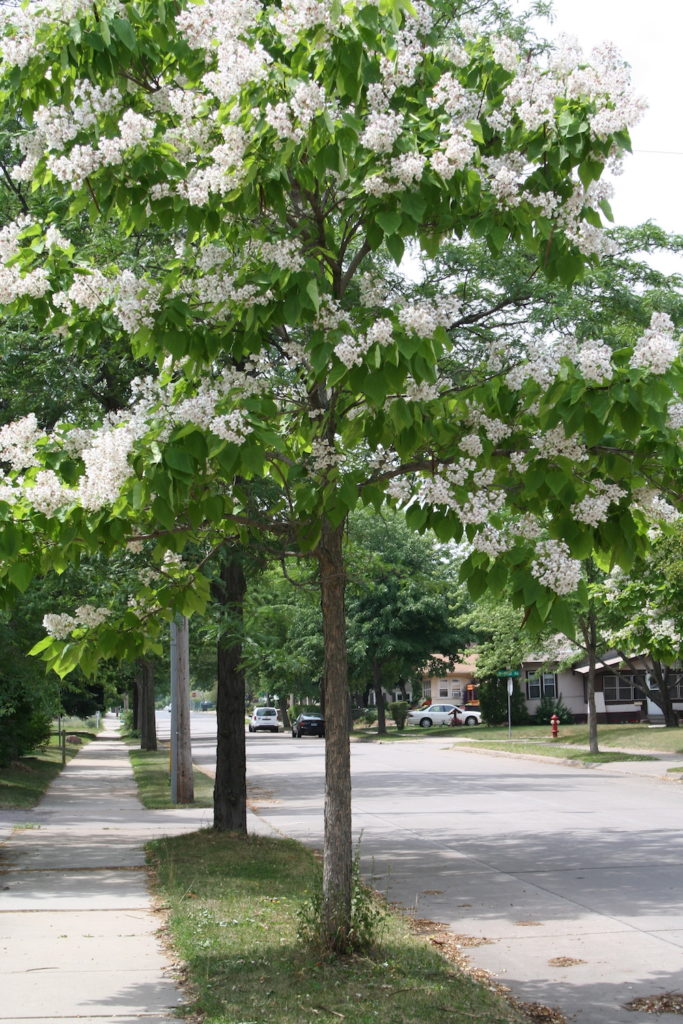Last week, I wrote about the top five trees for climate change that a St. Paul city forester recommends. They included some longtime favorites of mine, such as serviceberry and Kentucky coffeetree (actually a Minnesota native despite its name). The forester also suggested a few other trees that may seem like more unusual choices. But several of them are on a list of trees recommended by the University of Minnesota for those planting trees for 2050.

Catalpa. The first of the trees for climate change is a tree my late mother-in-law absolutely disdained: the northern catalpa. I can hear her now: “Mary, it’s a dirty, dirty tree!” The forester, Karl Mueller, acknowledged that catalpa (Catalpa speciosa) “can be messy,” but it has a lot to recommend it, too. It has large leaves, really pretty spring flowers and a “low vulnerability to climate change.” It can tolerate a lot of different soil conditions, including road salt, and occasional flooding. Since it has not been popular for quite awhile (see mother-in-law’s views above), it’s a good tree to plant to increase tree diversity in urban areas. Mueller also recommended the Chinese catalpa as a tough urban tree, though it may be difficult to find in nurseries.
Ohio Buckeye. Minnesota is outside the range of the Ohio buckeye (Aesculus glabra) but a cultivar called ‘Autumn Splendor’ is hardy to USDA Zone 4a (up to St. Cloud), possibly zone 3b. This is a small tree (up to 35-feet high) appropriate for smaller lots. It’s long-lived, grows moderately slowly and has pretty spring flowers and fall color. It produces nuts, which makes it popular with squirrels. It has one other flaw worth considering: The buckeye is one of several trees that can be host to the invasive Asian long-horned beetle. The beetle has never been found in Minnesota, however. It has gotten as far north as Chicago.

Tulip poplar. Northern Gardener wrote about the tulip tree (Liriodendron tulipifera) several years ago. A member of the magnolia family, the tulip poplar is marginally zone 4 hardy, so if you are planting it outside of the urban core of Minneapolis and St. Paul, you’ve got to consider it an experiment. (You can see a tree over on the University of Minnesota campus.) Tulip trees may be able to withstand climate change well, but they are tough to establish and require moist conditions at first. They are big, too—up to 90 feet tall. But, in the right situation, a tulip poplar would be stunning!
A few other trees suggested by Mueller are:
- ‘Silver Queen’ maple. A lower maintenance maple, but before planting any maples consider that they are already heavily planted throughout Minnesota. In St. Paul, for example, one-quarter of the trees in the city are maples.
- London planetree. A relative of the sycamore, London planetrees have interesting bark. They are only zone 5 hardy so consider this an experiment.
- Amur maackia — Another small, tough tree for urban lots. The University of Minnesota has introduced a variety called Summertime™ that is zone 3 hardy.
If you are interested in the best trees for climate change here in the North, check out this list from Gary Johnson of the University of Minnesota.
Tulip trees are great — fast growing, wildlife-friendly trees. They’re wonderful in our Western North Carolina mountain, where they’re native. Perhaps they’ll be great urban additions for you!
Reading this post has prompted me to look up my hardiness zone, but finding concrete information seems a little tough for the UK. In some charts I’m in 8b, and in some I’m zone 6. That’s a bit of a difference so I’m not sure what to go with.
Regardless, it looks like where I live is a little too warm for these trees.
The climate in the UK is very different from Minnesota, because we are in the middle of a continent — unfortunately, more like Siberia than Britain!
When I was in Amsterdam, I saw the London planetree for the first time – huge, magnificent maple-like leaves and the most incredible trunk – like an excited child had filled in the paint-by-number scheme with greens, whites, browns and yellows. So beautiful!
Sounds wonderful!